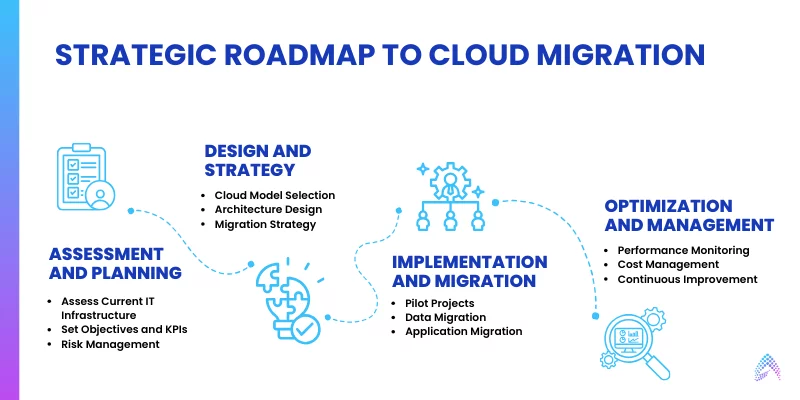Cloud Migration Role in Digital Transformation: The Strategic Roadmap

Imagine, you are on the F1 track with your junky car and competing against the latest Ferrari. What is your winning probability? That’s what using outdated legacy applications feels like in today’s business world.
In today’s business world, staying competitive means being nimble and innovative. Just like switching to a high-performance car, cloud migration offers flexibility to adapt to changing needs, scalability to grow effortlessly, and the ability to leverage cutting-edge tools for a competitive edge.
Cloud and Digital Transformation:
The role of cloud technologies in digital transformation is becoming increasingly significant, with projections indicating that the cloud will account for more than 65.9% of expenditures on application software by 2025, up from 57.7% in 2022. This rapid growth highlights businesses’ critical shift towards cloud-based solutions to enhance their agility, scalability, and innovation capabilities.
By moving applications and infrastructure to the cloud, organizations can streamline their operations, reduce costs, and respond more quickly to market changes, thereby gaining a competitive edge.
Gartner’s forecast that the move to the cloud will influence over $1.3 trillion in enterprise IT spending in 2022, rising to approximately $1.8 trillion by 2025, underscores cloud solution’s impact on the IT landscape.
This transition is not merely about shifting IT resources but represents a fundamental change in how businesses operate and deliver value. Cloud solutions allow you to convert and extend digital products without blowing the budget.
If you are ready to Retire outdated systems and embrace the exciting possibilities of the cloud, here is your strategic guide to digitally transform your business landscape through cloud migration.

Step 1: Assessment and Planning
1.1 Assess Current IT Infrastructure
Objective: Understand the current state of your IT infrastructure, applications, and workflows.
Action Steps:
Inventory and Analyze: Start by meticulously taking stock of your current IT landscape. Identify applications, data types, dependencies, and their resource consumption.
Analyze their cloud suitability factors like security, compliance, and performance needs.
Define Business Goals: Align your cloud migration plan with your broader digital transformation goals. Ex: increased agility, cost optimization, or improved disaster recovery, Having clear objectives ensures your migration strategy is laser-focused.
Example: A healthcare organization assesses its legacy electronic health record (EHR) systems and identifies outdated hardware and software that hinder performance and scalability.
1.2 Set Objectives and KPIs
Objective: Define clear goals and metrics to measure the success of the migration
Action Steps:
- Determine key business drivers for migration (e.g., cost savings, agility, innovation).
- Establish specific, measurable, achievable, relevant, and time-bound (SMART) goals.
- Identify key performance indicators (KPIs) to track progress.
Example: A financial services firm can set a goal to reduce IT operational costs by 25% within the first year post-migration and establish KPIs to measure cost savings, system uptime, and user satisfaction.
1.3 Risk Management
Objective: Identify potential risks and develop mitigation strategies.
Action Steps:
- Conduct a risk assessment to identify potential challenges and vulnerabilities.
- Develop a risk management plan, including rapid vulnerability detection, data encryption, backup solutions, and disaster recovery protocols.
- Implement security measures to protect data during and after migration.
Cloud Data Security Protocol Examples:
- Role-based Access Controls (RBAC) involve assigning permissions to individuals based on their role within the organization, such as their job function or department.
- Attribute-Based Access Controls (ABAC) incorporate permissions based on specific attributes such as user device security, geographic location, or time of day.
Step 2: Design and Strategy
2.1 Cloud Model Selection
Objective: Choose the appropriate cloud deployment model based on business needs.
Action Steps:
There’s no one-size-fits-all approach to cloud migration. Here are the most common strategies, each with its advantages:
- Lift and Shift: This quick and cost-effective method involves moving existing applications “as is” to the cloud. While efficient, it may not fully leverage the cloud’s potential.
- Refactoring: This strategy involves optimizing applications to utilize cloud-native features like scalability and elasticity fully. However, it requires more development effort.
- Hybrid Cloud: This approach creates a best-of-both-worlds scenario, where some applications remain on-premises while others move to the cloud. Ideal for organizations with complex compliance requirements.
Example: A global manufacturing company opts for a hybrid cloud model to balance cost savings and data security, using the public cloud for non-sensitive applications and the private cloud for critical operations.
Learn more about Cloud Smart Adoption Strategy to spend less and gain more from your cloud spending.
2.2 Architecture Design
Objective: Plan the architecture for the cloud environment.
Action Steps:
- Design the cloud architecture, including network configurations, security protocols, and compliance requirements.
- Ensure scalability and flexibility to accommodate future growth.
- Plan for integration with existing systems and applications.
2.3 Migration Strategy
Objective: Develop a comprehensive migration strategy.
Action Steps:
- Create a detailed migration plan with timelines, resource allocation, and milestones.
- Prioritize applications for migration based on business impact and complexity.
- Develop a phased approach to minimize disruption to operations.
Step 3: Implementation and Migration
Develop a Migration Plan: This detailed plan outlines the migration sequence, resource allocation, testing procedures, and rollback strategies for each application. A well-defined plan minimizes downtime and ensures a smooth transition.
Proof of Concept (POC): Conduct a POC with a non-critical application rather than a full-scale migration. This allows you to test your chosen migration strategy, identify potential roadblocks, and refine your approach.
Migration and Testing: Execute your migration plan meticulously, following the best security and data integrity practices. Rigorous testing throughout the process ensures a seamless transition and minimizes post-migration issues. Here’s where cloud penetration testing comes in – a powerful method to safeguard your cloud environment and empower your digital transformation journey.
Cloud penetration testing:
- Cloud penetration testing simulates real-world attacks, identifying weaknesses in your cloud infrastructure, applications, and configurations. This proactive approach prevents attackers from exploiting these vulnerabilities.
- Many regulations require companies to demonstrate robust security measures. Cloud penetration testing helps ensure your cloud environment meets compliance requirements, avoiding potential fines and legal issues.
- Digital transformation thrives on innovation. Cloud penetration testing ensures your cloud environment is secure enough to support innovative new applications and services.
3.1 Pilot Projects
Objective: Test the migration process with pilot projects.
Action Steps:
- Select a non-critical application for the pilot migration.
- Monitor the migration process, identify issues, and refine strategies.
- Gather feedback from stakeholders and make necessary adjustments.
3.2 Data Migration
Objective: Plan and execute data migration with minimal disruption.
Action Steps:
- Develop a data migration plan, including data cleansing and validation.
- Use data replication tools to ensure continuous data availability.
- Monitor the migration process and address issues promptly.
3.3 Application Migration
Objective: Migrate applications in stages to ensure compatibility and performance.
Action Steps:
- Re-platform or refactor applications to leverage cloud-native features.
- Test applications in the cloud environment to ensure functionality.
- Monitor performance and make necessary optimizations.
Step 4: Optimization and Management
Cloud migration isn’t a one-time event. Continuously monitor and optimize your cloud environment for cost efficiency and performance. Utilize cloud-native features like auto-scaling to adjust resource allocation dynamically based on demand.
4.1 Performance Monitoring
Objective: Continuously monitor performance and optimize cloud resources.
Action Steps:
- Use cloud monitoring tools to track resource usage and application performance.
- Set up automated alerts for performance issues and unusual activities.
- Regularly review performance metrics and implement improvements.
4.2 Cost Management
Objective: Implement cost management practices to optimize cloud spending.
Action Steps:
- Monitor cloud usage and identify cost-saving opportunities.
- Use cost management tools to track expenses and optimize resource allocation.
- Implement policies for cost control, such as rightsizing and auto-scaling.
4.3 Continuous Improvement
Objective: Foster a culture of continuous improvement.
Action Steps:
- Regularly review cloud performance metrics and gather feedback from users.
- Implement changes based on feedback and data analysis.
- Encourage innovation and experimentation with new cloud services and technologies.
Slack’s Digital Transformation Success Story With AWS Cloud Migration
- Challenge: Slack, a popular team communication platform, needed to handle its rapidly growing user base and data volume.
- Cloud Solution: Slack migrated its platform to AWS, leveraging its robust infrastructure and scalability features.
- Digital Transformation Impact: By utilizing the powerful and scalable infrastructure of AWS, Slack was able to accommodate its burgeoning user base effortlessly. This migration ensured that Slack’s platform could handle increased data volumes and user interactions without any hitches.
By aligning its IT infrastructure with its rapid growth, Slack enhanced its operational efficiency and delivered a superior user experience. The success of this migration underscores the critical role of cloud solutions in achieving digital transformation goals, providing a scalable and resilient foundation for future growth and innovation.
Unlock your business growth by delivering customer-centric services through cloud-native application development.
Lead Business Transformation With Cloud:
Cloud solutions are not just a technological upgrade; they are a fundamental enabler of digital transformation that drives business agility, innovation, and competitiveness. The cloud’s ability to provide real-time data insights and support agile methodologies empowers businesses to make informed decisions swiftly, adapting to market changes and staying ahead of the competition.
By integrating cloud-based AI, machine learning, and data analytics, businesses can unlock unprecedented levels of intelligence and automation, driving growth and sustaining competitive advantage.
The cloud is critical to the digital transformation journey for businesses aiming to lead their organizations into the future, offering a pathway to greater resilience, agility, and market leadership.
Schedule a free consultation workshop for a tailored plan to your specific needs and goals and discover the hidden opportunities a cloud migration presents for your business.

Director – Global Delivery




